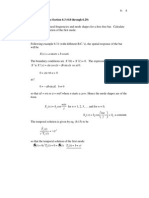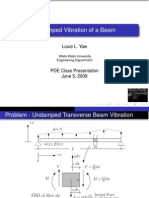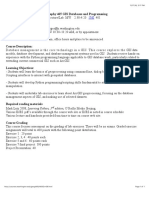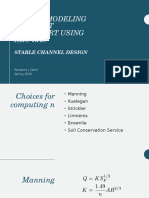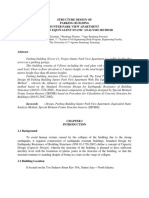Lab9 BeamLabSol
Lab9 BeamLabSol
Uploaded by
Patrick LeeCopyright:
Available Formats
Lab9 BeamLabSol
Lab9 BeamLabSol
Uploaded by
Patrick LeeOriginal Description:
Original Title
Copyright
Available Formats
Share this document
Did you find this document useful?
Is this content inappropriate?
Copyright:
Available Formats
Lab9 BeamLabSol
Lab9 BeamLabSol
Uploaded by
Patrick LeeCopyright:
Available Formats
1
CEE 220
Beam Lab
Lab Exercise
The purpose of this lab is to practice nding the deection of beams from both the moment curvature relation and the governing equation.
Materials
This Handout
Problem 1 - Beam with Concentrated Load
Consider the simply-supported beam subjected to a point load as shown below:
For the shown beam, the governing equation for bending of beams reduces to (w(x)=0):
d EI dx 4 = 0
4
The deection along the beam can be determined by integrating the governing equation four times. Due to the point load, which cannot be described by w(x)=0, separate equations must be used to represent the deection in the two halves of the beam. The following expressions result: (x) = 1 (x) = (x) = 2 (x) =
1 C 1 x3 EI ( 6 1 C 5 x3 EI ( 6
+ +
C2 x2 2 C6 x2 2
+ C3 x + C4 ) + C7 x + C8 )
for for
0 < x < L/2 L/2 < x < L
To determine the values of the constants of integration a total of four boundary and four compatability conditions are required. Determine the boundary conditions for the beam. 1. 1 (0) = 0 2. M1 (0) = 0 EI1 (0) = 0 3. 2 (L) = 0 4. M2 (L) = 0 EI2 (L) = 0
Implementing the boundary conditions results in the follow equations: 1 (x) = 2 (x) =
1 C1 x3 EI ( 6
+ C 3 x)
x2 L 2
for +
L3 3 )
0 < x < L/2 L/2 < x < L
x3 1 EI [C5 ( 6
+ C7 (x L)]
for
Verify these equations by evaluating the above boundary conditions. M = C1 x M = C5 (x L)
The remaining four constants of integration are determined using compatibility conditions. Find and list these four compatibility conditions for this problem below.
L L L L L 1. 1 ( L 2 ) = 2 ( 2 ) C1 48 + C3 2 = C5 48 (1 6 + 16) C7 2
L L L L 2. 1 ( L 2 ) = 2 ( 2 ) C1 8 + C3 = C5 8 (1 4) + C7 2
3. V1 P V2 = 0 (EI1 P EI2 = 0) C1 P C5 = 0
L L L 4. M1 + M2 = 0 (EI1 ( L 2 ) + EI2 ( 2 ) = 0) C1 2 + C5 ( 2 L) = 0
Hint: You are looking at two geometric conditions and two equilibrium conditions at the transition between solution 1 and solution 2. Draw a free body diagram which includes the concentrated force and internal forces and moments from both parts of the solution to nd the latter 2 equations.
Use the compatibility conditions to determine the remaining four constants of integration. From 3) and 4) C1 =
P 2
, C5 = P 2
2 2
3L From 2) C7 = C3 + C1 L 8 + C5 8 = C3
P L2 8
From 1)
P L3 2 48
PL + C3 L 2 = 2
11 48
C3 L 2 +
2
L3 16
C3 =
P L2 96 (11
2
L + 6 1) = P16
L C7 = 3P 16
Using the constants of integration that you just found, complete the following expressions for the deection along the beam. 1 (x) = 2 (x) =
P x3 EI ( 12 P 48EI [1
xL2 16 )
P L3 x 3 48EI [4( L )
x 3( L )]
x x 2 x 3 8L + 12( L ) 4( L ) ]
Use these expressions to determine the deection of the beam at midspan. (x =
L 2) PL = 48 EI
3
Note: This can be obtained from either v1 (L/2) or v2 (L/2).
Determine the reaction forces at points A and C. Hint: nd the transverse shear forces V(0) and V(L) from V(x). How are they related to the reaction forces at the boundary?.
RA = V (0) = C1 =
P 2
RB = V (L) = C5 =
P 2
Problem 2 - Beam with Applied Moment
Now consider a similar beam subjected to a moment load as shown below.
The deection of the beam under this loading can be represented by the following equations: (x) = 1 (x) = M 11 2 1 ( L x + x3 ) EIL 96 6 M 1 3 1 2 35 1 ( x x L + L2 x L3 ) EIL 6 2 96 32 for 0 < x < L/4
(x) = 2 (x) =
for
L/4 < x < L
Determine the boundary conditions for the beam and verify that the above solution satises them. 1. (0) = 0 = 1 (0)
2. (L) = 0 = 2 (L)
x 3. M (0) = 0 = EI1 (0) = M L
x=0
= M1 (x)
4. M (L) = 0 = EI2 (L) = M L (x L)
x=L
= M2 (x)
Determine the four compatibility conditions (at x=L/4) for the beam and verify that the above solution satises these conditions.
L 1. 1 ( L 4 ) = 2 ( 4 ) L 2. 1 ( L 4 ) = 2 ( 4 ) L M M 3. V1 ( L 4 V2 4 = 0 L ( L ) = 0 L M 4. M1 ( L 4 + M M2 4 = 0 L L 4
+M +
M L L (4
L) = 0
Determine the deection of the beam at point B. B = 2 (x
L 2) ML 3M L = 192 EI (4 24 + 35 6) = 64EI
3 3
Determine the maximum deection of the beam due to this moment loading. This implies nding the location of max v. We need to nd the location of max deection, so set = 0 and solve for x in terms of L. We have two functions, and we dont necessarily know the location at the outset, so we need to look at both equations.
M 1 3 11 2 1 3 2 1 (x) = EIL ( 11 96 L x + 6 x ) 96 L x + 6 x = 0 This has no real roots so the max deection doesnt occur between 0 and L/4. M 1 2 3 2 (x) = EIL (1 6x 2x L + 35 2 96 L x
1 3 32 L )
1 3 6x
2 1 2x L +
35 2 96 L x
1 3 32 L
=0
Solving this quadratic function gives x = (0.4796L,1.5204L). The max must be between 0 and L, so x = 0.4796L is the correct location.
L v2 (0.4796L) = 21M .286EI
2
Determine the reaction forces at points A and C due to this loading. Same FBDs as when nding the reactions in problem 1. RA = M L RB = V (L) = + M L
Problem 3 - Indeterminate Beam
Now consider the following statically indeterminate beam.
The support at point B can be replaced with the corresponding reaction force as shown below. However, since there is technically a support at point B we must also enforce that the support condition at point B is satised.
The principle of superposition can be used to represent this problem as the sum of the following two, previously solved problems as follows:
According to the principal of superposition the displacement of the beam is equal to the sum of the displacement of the beam in these two pictures. Use the support condition (boundary condition) at point B and your previous solutions to nd the support reaction RB . B =
M
= B
P =RB
ML = 3 64EI +
RB L3 48EI
= 0 (from B.C. at B) RB =
9M 4L
Determine the reaction forces at points A and C. RA = RB =
P 2 P 2
M L M L
= =
RB 2 R B 2
M L M L
M = 17 8L M = 1 8L
Determine the bending moment at point B.
M MB = 17 8L
L 2
1 + M = 16 M
Plot the shear and bending moment diagrams for the beam.
Problem 4 - Applying Failure Theories
If the A-36 steel pipe shown below has outer and inner diameters of 30mm and 20mm, respectively, determine the factor of safety against yielding of the material at point A according to:
1. The Maximum-Shear-Stress Theory
4 4 9 ) m4 Iz = 4 (0.015 0.01 ) = 10.15625 (10 4 4 9 J = 2 (0.015 0.01 ) = 20.3125 (10 ) m4
Fy = 0 : Vy + 900 900 = 0 Vy = 0 Mx = 0 : T + 900(0.4) = 0 T = 360 N m Mz = 0 : Mz + 900(0.15) 900(0.25) = 0 Mz = 90 N m
90(0.015) yA Normal Stress: x = M Iz = 10.15625 (109 ) = 42.31 M P a
Shear Stress: =
Tc J
360(0.015) 20.3125 (109 )
= 84.62 M P a
In-Plane Principal Stresses: x = 42.31 M P A, z = 0, xz = 84.62 M pa x + z x z 2 2 = 66.07 M P a, = 108.38M pa + ( ) + xz 1,2 = 1 2 2 2 1 and 2 are opposite sign. This requires: 1 2 = allow 66.07 (108.38) = allow allow = 174.45 M P a F.S. =
Y allow
250 174.45
= 1.43
2. The Maximum-Distortion-Energy Theory
2 2 2 1 1 2 + 2 = allow 2 2 66.07 (66.07)(108.38) + (108.38)2 = allow allow = 152.55 M P a
F.S. =
Y allow
250 152.55
= 1.64
You might also like
- Alastair I. M. Rae - Quantum Mechanics, Sixth Edition (6th Ed) (Instructor's Solution Manual) (Solutions) - Routledge (2015)Document158 pagesAlastair I. M. Rae - Quantum Mechanics, Sixth Edition (6th Ed) (Instructor's Solution Manual) (Solutions) - Routledge (2015)Manuel SalazarNo ratings yet
- Calculus II Cheat SheetDocument4 pagesCalculus II Cheat SheetajznelsonNo ratings yet
- Physics 21 SolutionsDocument92 pagesPhysics 21 SolutionsOğuzhan Odbay100% (1)
- Partial Differential EquationDocument9 pagesPartial Differential EquationEng Shakir H100% (2)
- SolutionsTute2 PDFDocument9 pagesSolutionsTute2 PDFShweta SridharNo ratings yet
- Double IntegrationDocument22 pagesDouble IntegrationIvan Hernandez100% (1)
- Exercicios Capitulo 12Document19 pagesExercicios Capitulo 12Weniton OliveiraNo ratings yet
- HW 2 SolutionDocument5 pagesHW 2 SolutionSSNo ratings yet
- Clamped 1Document21 pagesClamped 1Rajeswari MachirajuNo ratings yet
- Chapter 6 - Beam DeflectionsDocument56 pagesChapter 6 - Beam DeflectionsJovy NotorioNo ratings yet
- Applications Diffrntl EqnsDocument20 pagesApplications Diffrntl EqnsMujeeb AbdullahNo ratings yet
- 4 Notes 15 Pure Warp PDFDocument6 pages4 Notes 15 Pure Warp PDFjianjungbdNo ratings yet
- CH 05Document38 pagesCH 05Alfredo Ruben Tapia VelasquezNo ratings yet
- Section A3.4: Power Series SolutionDocument7 pagesSection A3.4: Power Series SolutionAdzar JumaaniNo ratings yet
- Undamped Vibration of A Beam: Louie L. YawDocument16 pagesUndamped Vibration of A Beam: Louie L. YawdrnicolasNo ratings yet
- Principles of Matlab (Fall 07) Workout #1Document11 pagesPrinciples of Matlab (Fall 07) Workout #1Karim GaberNo ratings yet
- Numerical Integration and DifferentiationDocument2 pagesNumerical Integration and DifferentiationGaurav UpadhyayNo ratings yet
- Section6 5 PDFDocument9 pagesSection6 5 PDFAyalsew DagnewNo ratings yet
- Electricity and Magnetism II - Jackson Homework 11Document5 pagesElectricity and Magnetism II - Jackson Homework 11Ale GomezNo ratings yet
- Be Mechanical-Engineering Semester-3 2019 May Strength-Of-Materials-CbcgsDocument17 pagesBe Mechanical-Engineering Semester-3 2019 May Strength-Of-Materials-Cbcgsmahesh mishraNo ratings yet
- F07 Hw06aDocument13 pagesF07 Hw06aAdam ChanNo ratings yet
- Mathematics of FinanceDocument5 pagesMathematics of FinanceMuhammad JamilNo ratings yet
- 6.641 Electromagnetic Fields, Forces, and Motion: Mit OpencoursewareDocument8 pages6.641 Electromagnetic Fields, Forces, and Motion: Mit OpencoursewareAhmed AiadNo ratings yet
- Torsional Stress and Double IntegrationDocument12 pagesTorsional Stress and Double IntegrationMr. DummyNo ratings yet
- Jackson 9.10, 9.16Document13 pagesJackson 9.10, 9.16razarizvi1No ratings yet
- Personnal Work MIA PBL 7Document5 pagesPersonnal Work MIA PBL 7Gloire MATHE-MUKUHINo ratings yet
- Final Exam: N+ N Sin NDocument9 pagesFinal Exam: N+ N Sin NtehepiconeNo ratings yet
- ch36 PDFDocument11 pagesch36 PDFRodrigo S QuirinoNo ratings yet
- Problem 11.1: (A) : F (Z) Z X (Z) F (Z) F Z + ZDocument9 pagesProblem 11.1: (A) : F (Z) Z X (Z) F (Z) F Z + Zde8737No ratings yet
- Curve FittingDocument21 pagesCurve FittingthebaraapispamNo ratings yet
- TE Report LastDocument11 pagesTE Report LastManu SwarnkarNo ratings yet
- PDF 6 Mechanics of DBDocument18 pagesPDF 6 Mechanics of DBRizette PaloganNo ratings yet
- 18.03 Pset 4Document36 pages18.03 Pset 4Justin CollinsNo ratings yet
- PDFDocument7 pagesPDFAliOucharNo ratings yet
- JEE Main 2023 B Arch and B Planning SolutionDocument25 pagesJEE Main 2023 B Arch and B Planning Solutionpalak.ty2005No ratings yet
- 1p1a MT11Document5 pages1p1a MT11Theo IstrateNo ratings yet
- I. Exercise 1: R Na0 R A0Document4 pagesI. Exercise 1: R Na0 R A0jisteeleNo ratings yet
- 3-6. Bimolecular Reaction in A Liquid Film: From The Problem StatementDocument9 pages3-6. Bimolecular Reaction in A Liquid Film: From The Problem Statement黄仁镜No ratings yet
- AssignmentDocument8 pagesAssignmentKhalid KhanNo ratings yet
- 69 75Document10 pages69 75Carlos Moran CepedaNo ratings yet
- Calculus 141, Section 8.6 The Trapezoidal Rule & Simpson's RuleDocument4 pagesCalculus 141, Section 8.6 The Trapezoidal Rule & Simpson's RuleChathuranga ManukulaNo ratings yet
- Manual IndexingDocument41 pagesManual IndexingBasharat AhmadNo ratings yet
- Bifurcation 3Document7 pagesBifurcation 3Mainak ChatterjeeNo ratings yet
- A Math Formula (Indices, Surds, Log, Linear Law, Circular Measure)Document4 pagesA Math Formula (Indices, Surds, Log, Linear Law, Circular Measure)Hexen Ong Chang ZhuangNo ratings yet
- Problem 4.5 (A) (B) (C) (D)Document11 pagesProblem 4.5 (A) (B) (C) (D)Steve HoNo ratings yet
- Calculus II MAT 146 Additional Methods of Integration: Sin Sinx Sin Sinx 1 Cos Sinx Sinx Cos Sinxdx Sinx CosDocument7 pagesCalculus II MAT 146 Additional Methods of Integration: Sin Sinx Sin Sinx 1 Cos Sinx Sinx Cos Sinxdx Sinx Cosmasyuki1979No ratings yet
- Solution To The Schrodinger Equation For A Linear 1 D PotentialDocument12 pagesSolution To The Schrodinger Equation For A Linear 1 D PotentialbobNo ratings yet
- Least SquareDocument43 pagesLeast SquareShane ChuNo ratings yet
- 114 119Document9 pages114 119Carlos Moran CepedaNo ratings yet
- 13 6 Integrtn Trig FunctnsDocument15 pages13 6 Integrtn Trig FunctnsDaniel SHNo ratings yet
- EE203 Chapter 2 Solve ODE Using Power SeriesDocument34 pagesEE203 Chapter 2 Solve ODE Using Power Series许凉发No ratings yet
- MATH 1432 (Cal II) Final Exam ReviewDocument7 pagesMATH 1432 (Cal II) Final Exam Reviewyvcala456No ratings yet
- Static Equilibrium: M M M F F FDocument41 pagesStatic Equilibrium: M M M F F FINMENo ratings yet
- SPM Add Maths Formula List Form4Document16 pagesSPM Add Maths Formula List Form4Alvin HonNo ratings yet
- Grobler AJ Chapter4Document14 pagesGrobler AJ Chapter4hieuhuech1No ratings yet
- Mathematics 1St First Order Linear Differential Equations 2Nd Second Order Linear Differential Equations Laplace Fourier Bessel MathematicsFrom EverandMathematics 1St First Order Linear Differential Equations 2Nd Second Order Linear Differential Equations Laplace Fourier Bessel MathematicsNo ratings yet
- A-level Maths Revision: Cheeky Revision ShortcutsFrom EverandA-level Maths Revision: Cheeky Revision ShortcutsRating: 3.5 out of 5 stars3.5/5 (8)
- Student Solutions Manual to Accompany Economic Dynamics in Discrete Time, second editionFrom EverandStudent Solutions Manual to Accompany Economic Dynamics in Discrete Time, second editionRating: 4.5 out of 5 stars4.5/5 (2)
- Bellevue Mmlos FinalDocument90 pagesBellevue Mmlos FinalPatrick LeeNo ratings yet
- GEOG 360 Syllabus PDFDocument6 pagesGEOG 360 Syllabus PDFPatrick LeeNo ratings yet
- Geog 465 Syllabus PDFDocument1 pageGeog 465 Syllabus PDFPatrick LeeNo ratings yet
- Steel Structure Lecture - TorsionDocument45 pagesSteel Structure Lecture - TorsionPatrick LeeNo ratings yet
- Hall Harvest Funding ProposalDocument12 pagesHall Harvest Funding ProposalPatrick LeeNo ratings yet
- Eastlake Neighborhood Analysis Summary: Population DistributionDocument2 pagesEastlake Neighborhood Analysis Summary: Population DistributionPatrick LeeNo ratings yet
- Simple Procedure For Seismic Analysis of Seismic TanksDocument6 pagesSimple Procedure For Seismic Analysis of Seismic TanksMuhammad Usman100% (1)
- Analysis and Design of Steel A FloatingDocument9 pagesAnalysis and Design of Steel A Floatinginno musiimeNo ratings yet
- ETABSDocument7 pagesETABSV.m. RajanNo ratings yet
- 10 Prepar Ation and FabricationDocument18 pages10 Prepar Ation and Fabricationryan310393No ratings yet
- CE135 - 6. Shear and Diagonal TensionDocument34 pagesCE135 - 6. Shear and Diagonal TensionApril ImNo ratings yet
- (POPOV) Advances in Design of Eccentrically Braced FramesDocument13 pages(POPOV) Advances in Design of Eccentrically Braced Frameshal9000_mark1No ratings yet
- Apsara BorderDocument15 pagesApsara BorderskumarsrNo ratings yet
- Btech Ce 5 Sem Structural An02 2021Document2 pagesBtech Ce 5 Sem Structural An02 2021sky885921No ratings yet
- STR2 Shear Force in A BeamDocument5 pagesSTR2 Shear Force in A BeamhcghgnNo ratings yet
- Thumb Rules BuildingsDocument6 pagesThumb Rules Buildingsapi-3697897100% (3)
- Connections-I Bolted ConnectionsDocument21 pagesConnections-I Bolted ConnectionsA.k.MandalNo ratings yet
- Ce8301 - QB - 2markDocument25 pagesCe8301 - QB - 2markflora sharaNo ratings yet
- 4 - Qualitative Analysis PDFDocument67 pages4 - Qualitative Analysis PDFkyekwa2No ratings yet
- Lab 2: Fundamental Concepts: Beam BendingDocument21 pagesLab 2: Fundamental Concepts: Beam BendingudithaireshaNo ratings yet
- Design Method For End-Plate Bolted ConnectionsDocument12 pagesDesign Method For End-Plate Bolted Connectionsdheeraj SureshNo ratings yet
- Chapter8 - Design Theory & Procedure PDFDocument407 pagesChapter8 - Design Theory & Procedure PDFJunwhan KimNo ratings yet
- Performance of Grade 500 Steel in Concrete Structure.Document7 pagesPerformance of Grade 500 Steel in Concrete Structure.Ahetesham Uddin Ahmed TipuNo ratings yet
- Etabs TablesDocument5 pagesEtabs TablesWilsonNo ratings yet
- Lecture 2bDocument22 pagesLecture 2bTanu BoltaNo ratings yet
- Loading Tests of Highway Bridges in Slovakia: Alojz KopácikDocument7 pagesLoading Tests of Highway Bridges in Slovakia: Alojz KopácikPACO PAQUETINESNo ratings yet
- 04 Design of Prestressed Girder Bridges Using High Performance Concrete - An Optimization ApproachDocument16 pages04 Design of Prestressed Girder Bridges Using High Performance Concrete - An Optimization ApproachStephen Musenga ChiwamaNo ratings yet
- Lateral Torsional Buckling of Steel Thin-Walled Beams With Lateral RestraintsDocument6 pagesLateral Torsional Buckling of Steel Thin-Walled Beams With Lateral RestraintssaddamNo ratings yet
- Doubly Reinforced BeamDocument19 pagesDoubly Reinforced BeamLavender HoneyNo ratings yet
- Dome StructuresDocument8 pagesDome StructuresAdamu SuleimanNo ratings yet
- ... Ratchetting and Ratchetting Boundary Study of Pressurized Straight Low Carbon Steel PipeDocument11 pages... Ratchetting and Ratchetting Boundary Study of Pressurized Straight Low Carbon Steel PipeAmir mahmoudi motlaghNo ratings yet
- Reinforced Concrete Bridge Design CalculDocument60 pagesReinforced Concrete Bridge Design CalculSumudu Dilshan100% (1)
- Ub356 Bolted SpliceDocument4 pagesUb356 Bolted SpliceihpeterNo ratings yet
- Lecture 3 Bending and Shear in Beams PHG A8 2oct16Document30 pagesLecture 3 Bending and Shear in Beams PHG A8 2oct16HarithSilvaNo ratings yet
- Worked Example Moment DistributionDocument12 pagesWorked Example Moment DistributionMohamed100% (1)
- Structure Design of Parking Building Sun PDFDocument16 pagesStructure Design of Parking Building Sun PDFHoHo WindyantoNo ratings yet








